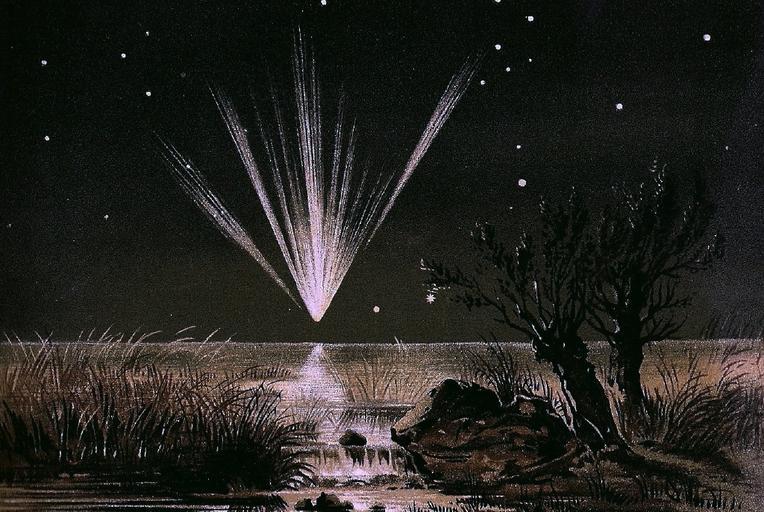MAKE A MEME
View Large Image

| View Original: | Great_Comet_1861.jpg (1024x686) | |||
| Download: | Original | Medium | Small | Thumb |
| Courtesy of: | commons.wikimedia.org | More Like This | ||
| Keywords: outdoor The Great Comet of 1861 formally designated C/1861 J1 and 1861 II, is a long-period comet that was visible to the naked eye for approximately 3 months. It was categorized as a Great Comet, one of the eight greatest comets of the 19th century, according to Donald Yeomans. On June 30, 1861, the comet made its closest approach to the Earth at a distance of 0.1326 AU (19,840,000 km; 12,330,000 mi). During the Earth close approach the comet was estimated to be between magnitude 0 and −2 with a tail of over 90 degrees. As a result of forward scattering C/1861 J1 even cast shadows at night (Schmidt 1863; Marcus 1997). During the night of 1861 June 30 – July 1, the famed comet observer J. F. Julius Schmidt watched in awe as the great comet C/1861 J1 cast shadows on the walls of the Athens Observatory. The comet may have interacted with the Earth in an almost unprecedented way. For two days, when the comet was at its closest, the Earth was actually within the comet's tail, and streams of cometary material converging towards the distant nucleus could be seen. en.wikipedia.org/wiki/C/1861_J1 The Great Comet of 1861 formally designated C/1861 J1 and 1861 II, is a long-period comet that was visible to the naked eye for approximately 3 months. It was categorized as a Great Comet, one of the eight greatest comets of the 19th century, according to Donald Yeomans. On June 30, 1861, the comet made its closest approach to the Earth at a distance of 0.1326 AU (19,840,000 km; 12,330,000 mi). During the Earth close approach the comet was estimated to be between magnitude 0 and −2 with a tail of over 90 degrees. As a result of forward scattering C/1861 J1 even cast shadows at night (Schmidt 1863; Marcus 1997). During the night of 1861 June 30 – July 1, the famed comet observer J. F. Julius Schmidt watched in awe as the great comet C/1861 J1 cast shadows on the walls of the Athens Observatory. The comet may have interacted with the Earth in an almost unprecedented way. For two days, when the comet was at its closest, the Earth was actually within the comet's tail, and streams of cometary material converging towards the distant nucleus could be seen. en.wikipedia.org/wiki/C/1861_J1 Great Comet 1861.jpg Great Comet of 1861 also known as C/1861 J1 or comet Tebbutt E Weiß Bilderatlas der Sternenwelt Published 1888 E Weiß Copyright expired book printed in 1888 author died in 1917 PD-old checked Comets in art 1861 1861 User Vesta The Great Comet of 1861 formally designated C/1861 J1 and 1861 II, is a long-period comet that was visible to the naked eye for approximately 3 months. It was categorized as a Great Comet, one of the eight greatest comets of the 19th century, according to Donald Yeomans. On June 30, 1861, the comet made its closest approach to the Earth at a distance of 0.1326 AU (19,840,000 km; 12,330,000 mi). During the Earth close approach the comet was estimated to be between magnitude 0 and −2 with a tail of over 90 degrees. As a result of forward scattering C/1861 J1 even cast shadows at night (Schmidt 1863; Marcus 1997). During the night of 1861 June 30 – July 1, the famed comet observer J. F. Julius Schmidt watched in awe as the great comet C/1861 J1 cast shadows on the walls of the Athens Observatory. The comet may have interacted with the Earth in an almost unprecedented way. For two days, when the comet was at its closest, the Earth was actually within the comet's tail, and streams of cometary material converging towards the distant nucleus could be seen. <a href="https://en.wikipedia.org/wiki/C/1861_J1" rel="nofollow">en.wikipedia.org/wiki/C/1861_J1</a> | ||||